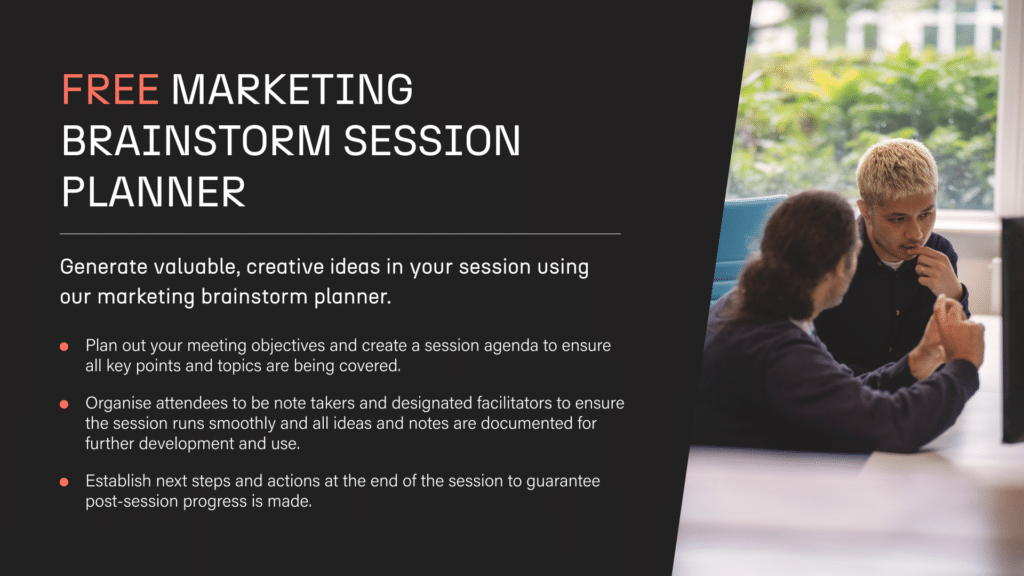How to Run a Marketing Brainstorm that’s Worth the Time [with Planner Template]
Brainstorming has earned a bad reputation. Too often, marketing teams schedule idea generation sessions, only to leave with amorphous, half-formed ideas. But it doesn’t have to be this way.
If you want to generate valuable, creative ideas through brainstorming, our guide can help. We’ve included best-practice tips and proven techniques to help your brainstorming efforts garner the results you’re looking for.
Quick Links
- Do I Need a Brainstorming Session?
- Things to Prepare Before a Brainstorming Session
- The Basics of Brainstorming
- Warm-up Techniques and Idea Generation
Do I Need a Brainstorming Session?
Generating new ideas as a group is well worth doing – it facilitates contribution, allows for fresh perspectives from a range of people, and allows colleagues to become more comfortable with speaking up. And all of these benefits are great for things like team morale, employee engagement and productivity.
But if you can bounce around suggestions on Slack or over email, then don’t go scheduling in that Zoom session just yet. A proper brainstorming sesh requires time, effort and preparation to pull off properly. Everyone’s time is precious, and gathering your colleagues together, whether it’s in person or remotely, for what ultimately ends up being a ten-minute discussion is going to mess with their own workflow.
If you’ve got a large project coming up, something that requires input and expertise from a range of people, then a brainstorming session is definitely the done thing. And as you’ll soon see, a brainstorming session with the proper amount of preparation and thought put into them can pay off in a big way.
What does ideation mean?
You may have seen the term ideation used in the same breath as brainstorming. If so, there’s no reason to be confused, it’s just an umbrella term for generating ideas, with brainstorming simply being a type of ideation. Whichever you see used, just know that they’re chiefly concerned with coming up with new ideas as part of the creative process.
Things to Prepare Before a Brainstorming Session
Invite the Appropriate People
Inviting the right people is fundamental to an effective brainstorming session. Not only do you not want to waste anyone’s time, you want results.
Remember that the right people might not be those you work with day-to-day. Enlisting people from other teams and departments will bring fresh perspectives, knowledge and experience – helping to create a more feasible and diverse range of ideas.
And don’t go overboard on the invites; 3-6 participants will ensure everyone gets a say.
Write Down Clear Objectives
Defining the problem brings context, so set out with clear objectives in mind. Share a list of goals to start the ball rolling and save time at the start of the session.
This is a good opportunity to define the boundaries and limitations of the campaign, so note budget or time constraints that will steer people in the right direction and limit unfeasible ideas.
Set an Agenda
Your brainstorming session should have structure; it should not be a free-for-all. Setting an agenda ensures no time is wasted on half-baked ideas or wishy-washy techniques.
If there are multiple points of business, prioritise the most important to hit these while participants are fresh and motivated. You should also allot time to any brainstorming techniques you’d like to incorporate (more on this later).
Prepare the Necessary Tools and Materials
Organisation is key to a productive brainstorm, so get everything ready to make full use of the session. Here’s a list of things to prepare before a brainstorm:
- Book the space and make sure it’s free when the session is due to start
- Prepare the necessary hardware (syncing to a projector, connecting to the meeting room Wi-Fi, etc.)
- Print collateral (agenda, campaign notes, etc.)
- Provide paper, pens and other materials where necessary
- Provide water and refreshments to keep the team motivated
Ask People to Arrive with Ideas
Brainstorming from standstill is challenging, which is why it can be useful to ask participants to arrive with a few loose ideas. As part of the session invite, list what you hope to achieve, including any notes or limitations, and ask that each person prepares 3-5 ideas to lay the foundations for a productive session.
From here, you can build on and discuss individual ideas, generating concrete solutions more efficiently. It will also imbue participants with confidence, so they’ll be forthcoming with their ideas.
Invite Anonymous Submissions Before the Meeting
A good way to allay concerns of sharing ideas in a group is to invite anonymous submissions, which can then be discussed openly and impartially at the start of the session. This is great for groups comprising of individuals who don’t normally work together, and ensures that the meeting gets off to a productive start.
The Basics of Brainstorming
Keep the Meeting to Around 20-30 Minutes
Provided there’s been adequate preparation, 20-30 minutes is a reasonable ballpark for a brainstorm session. This gives both sufficient time for idea generation, without the meeting veering off course or participants losing focus.
To ensure that you can stick to this time limit, it may be necessary to enforce house rules. Ask participants not to use laptops or other devices, as these can be a distraction, and try to discourage any chat which isn’t related to the session objectives.
While limiting a brainstorming session may seem counterintuitive to idea generation, the prospect of a deadline can help participants to focus and thrive under pressure.
Don’t Be Afraid to Say ‘No’ to Unfeasible Ideas
If you feel the session isn’t going the way you’d envisioned, steer it back in the right direction by addressing unfeasible ideas. While participants should feel they can voice left-field ideas, you may need to intervene should things stray too far from the goals of the session.
Have a Designated Facilitator
A senior member of the team should act as a session facilitator; this could be you or someone you’re working closely with as part of the project. The facilitator’s job is to ensure that the session stays on track, with all points of business addressed as allocated by the agenda.
Ask One Person to Take Notes
Assign a scribe to take notes throughout the session, jotting down any and all ideas voiced by the team. While certain brainstorming techniques often include some element of note-taking, assigning someone to record everything will make sure no good ideas fall through the cracks; you could even record the session to listen back when it’s convenient.
One of the best things about having a dedicated note-taker is that it prevents the team from becoming distracted, burying their nose in their laptop or notebook rather than contributing to the session.
Warm-up Techniques and Idea Generation
Brainwriting
We find ‘brainwriting’ to be one of the most effective means of brainstorming as a team. This is when each member of the team writes down an idea, before passing it on to the next person. They then build out and develop, introducing their own ideas and solutions to flesh the original idea out into a conceivable project.
At the end of the session, you’re left with a collection of fully-formed ideas which can be discussed, refined and prioritised. What’s great about brainwriting is that it combines both independent thinking with team collaboration, as well as the opportunity to feedback on ideas some people may have been too self-conscious to voice.
Grid Generator
The grid generator technique is when members of the team fill in a complete grid with ideas, before combining them to expand on the initial idea and find tangible solutions. Start by drawing up a grid whose rows and columns equal the number of people in the brainstorming team. Then, pass the grid around so that each person can share an idea.
When the grid is full, combine ideas from different rows and columns to flesh them out. This is particularly good if you’re working in a large brainstorming group or are hoping to attain multiple ideas from the session.
Bubbles
Bubbles is similar to mind mapping, and is effective for both individual and group brainstorming. Begin by drawing nine circles on a sheet of paper, with the problem or theme written in the centre circle. In the remaining eight circles, jot down ideas from the team, before selecting the strongest one.
From here, repeat the process, only this time put the chosen idea in the centre of the nine circles. Develop this by adding ideas and solutions to the other eight circles; you can do this for as long as you like, drawing up new circles to further refine and develop the idea until you’ve exhausted its possibilities.
Idea Face-Off
When you’ve accrued lots of ideas at the end of a brainstorm, it’s important to sort the wheat from the chaff and leave with a solid handful of options that will be feasible beyond the boardroom.
A good way to do this is to face off ideas against each other until you’re left with a selection that the team agrees upon. Do this by weighing up the pros and cons of each idea, before pitting them against one another and scrapping those that don’t make the cut. This is a great way to democratically cull any ideas which may not have legs in the real world.
Download Your Free Marketing Brainstorm Planner

Ready to put your heads together and get the best from your brainstorming? Be sure to use our free, downloadable Marketing Brainstorm Planner so you can keep your meetings organised, on topic and as effective as possible. It’ll also give you a place to keep details of your meeting objectives, personnel, agenda and further actions in one handy place.
You can grab it below, just enter your details and it’s yours:
At Banc, our team of experts instil creativity into all our client campaign work, using both new and time-tested solutions to solve problems and meet objectives. For more information about how we can help your business, visit the homepage or get in touch today on 0345 459 0558.



